Randall Lang's Blog, page 2
February 7, 2011
Quest for Shangri-La
Enough trains already! Well, maybe not just yet. In an effort to escape grey drizzly skies, snow flurries, biting cold, and the weatherman's twisted concept of 'partly cloudy', I made a January pilgrimage to the Gulf Coast of Florida. It was a quest to find that most elusive dream, a coastal drinking village with a fishing problem. The kind of town where you could swear that you just saw Ernest Hemmingway, and where the bar stools are occupied at 10 AM. A writers' haven filled with colorful characters who spin tales of adventure, and where even the morning coffee has an umbrella in it.
Knowing that I was only hours ahead of a monumental snowstorm that had left Kansas in the stone age, had crippled Chicago, and which had the northeast in it's cross hairs, my butt was smokin' southward. With the skies turning an angry grey, I pulled into the Amtrak station in Lorton, Virginia, the home of the Auto Train. For any who are unfamiliar with this marvel of transportation, it is one of the few remaining passenger trains, but this one has the added bonus of allowing you to take your car along. With an average of 30 multi-level auto carriers and 750 passengers in 25 passenger service rail cars, the Auto Train is the longest train in the world, extending 3/4 of a mile in length. It runs only between Lorton, VA and Sanford FL, near Orlando. (Right click and 'open in new window')At the check-in booth near the station entrance, I received my car number and instructions as to what to do next. Guided into a temporary parking space by one of several auto attendants, I gathered up my overnight bag and ticket paperwork while my car was video-documented for pre-existing damage. With number 430 magnetically attached to the driver's door, I stood watching as my car was whisked away, up a ramp and into one of the numerous cavernous auto carriers. I could only hope that it would find a cute little compact or a brightly colored Corvette to get chummy with during the long night's journey.
Inside the station, I was startled by the number of people already there. Almost every one of the hundreds of seats was occupied, some by people with enough luggage for a two week trip rather than an overnight stay. I couldn't help but wonder where they intended to put it all, and why they felt the need for so much 'stuff'. There comes a point where you cease to look like a traveller and start to look like a refugee.
The check-in process was brief and efficient, giving me my room assignment, dining schedule, and the other general information required for the trip. After a wait of half an hour spent watching the media's panic over the approaching weather, passengers were called to board.
I have ridden trains before, starting as far back as the late 1950's. Then, my mother gathered up my brother and my pre-teen self to catch a Chicago bound train at Connellsville, PA. At that time it was a one and a half day trip, and a wondrous adventure for a kid. With a sleeping room, the trip was far less testing than it would have been in a "comfortable reclining chair" in the coach section. Many years later, in the 1990's, I took the Auto Train to Florida and was surprised to find the same room accommodations, rolling stock, and positive attitude toward customer service that I remembered from the 50's. One of my favorite features of both trains was the "observation car", a glass-domed car with elevated seats that allowed passengers to look around freely at the scenery and out over the train while it snaked through the countryside. I was to be disappointed on this trip by the absence of that car.
During that 1990's trip, a walk through the coach section during the night had shocked me. What had been an orderly place with rows of seats like an airliner had been transformed into something from a third world country. Pajama-clad children lay trying unsuccessfully to sleep across seats and in the aisle, food bags, toys, blankets, pillows, and drink bottles lay strewn about, while disheveled, exhausted adults struggled in vain to pacify their young. All that was missing were the goats and chickens. I remember wondering why AMTRAK had not reinstituted the old Pullman cars where coach passengers could sleep in upper and lower burth (bunk) beds behind privacy curtains. That would have to be better than the 'cattle car' atmosphere in the coaches. It appears that someone at AMTRAK had a similar idea, but applied it to the sleeper passenger cars instead of the coaches.
My previous trips had been in a reasonably comfortable bedroom that slept four and had a private bathroom. That was then, this is now. The new 'Superliner Sleeper Cars' have two levels of full-sized bedrooms, handicapped-accessible bedrooms, and communal toilet and shower facilities on the ends with rows of 'roomettes' in between. A 'roomette' is 3'6" by 6'6" with two single seats that convert into the lower bed while an upper bed folds down from the ceiling. It has no toilet or wash facilities. With the sliding door closed, there is room to stand and turn around, but this is no place for a claustrophobic. That being said, I found the arrangement infinitely roomy when compared to the extreme confines of airplane travel. My cubicle was on the upper level of the car, providing me a better view than those on the lower level. (Right click and 'open in new window')
http://www.youtube.com/watch?v=0ADlUKmUuKY
http://www.youtube.com/watch?v=Mfyciq2iiiU
(Not my videos but really cool)
Following the train's timely departure at 4 PM, I sat happily watching the miles and nameless towns fall behind. I was surprised to find absent the hypnotic 'click-clack' of the wheels on the rail joints. Apparently either the rails now have welded joints or the rail cars have dampening buffers that no longer transfer the noise. Whatever the reason, the train seemed to glide almost soundlessly along the tracks. Approaching an hour into the journey, there was an announcement that the dining car was open for the 5 PM seating. Because the dining car has limited seating, passengers must choose from 5 PM, 7 PM, or 9 PM dinners. The 7 PM session was apparently the most popular and was closed, prompting my choice of the early meal. With little red ticket in hand, I made my way along the narrow hallway and down the stairs to the dining car. A railroad dining car has a degree of romance associated with it generated by years of books and movies. Many of those 1940's movies, with the likes of William Powell and Myrna Loy, contained scenes of romantic chat across a white table clothed table with a red rose in a silver vase, while the scenery floated by in the background. Dining cars haven't changed much. The white table cloth and red rose are still there. To a degree, the service and elegance are also still there, albeit more efficient and sterile as dictated by current times. The menu was limited by restaurant standard, but completely adequate for a hungry traveller. Entree choices of chicken, beef, pasta, or fish were accompanied by salad and choice of dessert, all served promptly and without drama. At my table were a lady from New Jersey (obvious after her first words) who was travelling to stay with her daughter; and, a man from Cumberland, Maryland who was scouting Florida's east coast for his future winter home. Not present, gratefully, were children of any age, making the twenty-something servers the youngest in the room. Actually, my displeasure with children in restaurants is not so much with misbehaving children as it is with the annoying adults who inexplicably believe that they can negotiate their disruptive darlings back into control. "The definition of insanity is...". Having a meal and peaceful adult conversation without distraction was, by itself, worth the train fare. What is any good meal without continued conversation over cocktails? By moving to the lounge car, we extended our evening with the help of several greatly-overpriced beverages. The scheduled movie was Gene Kelly and Debbie Reynolds in the 1952 classic, "Singing in the Rain". The simple mention of the movie brought groans from those present, most of whom could remember being dragged to the theater as children by their mothers for two hours of crushing boredom while mom revelled in the singing and dancing. The courteous bar steward expressed his gratitude at not having to run the movie. He responded more enthusiastically to calls for several other movies involving "Debbie" and offered to search the crew quarters where he assured us that such fare was readily available. As the evening wore on, I found myself more and more missing the observation car. Even at night, it was fascinating to sit up high and watch the scenery go by, as if the backdrop of houses, roads, cars, and people was being presented solely for my entertainment. Cars and trucks had to stop at the crossing gates and red flashing lights while we, like some kind of royal procession, glided smoothly by. But, alas, another icon of more luxurious times has fallen to the wayside. With little else to do, it was time to retire. It took just minutes for the car steward to convert my roomette into sleep mode. In what would prove to be a bad choice, I climbed into the upper berth to discover two disconcerting facts: 1) the upper berth was 6'2" from wall to wall, and 2) the ceiling of the car was just inches from my face. Being 6 feet tall, the additional 2" left precious little wiggle room for someone who was used to sleeping diagonally in a roomy queen size bed. Finding a comfortable position was, to say the least, challenging. Fortunately I'm not a 'back-sleeper'. In that position with eyes open, I had this irrational desire to pound on the ceiling while screaming, "I'm alive! I'm alive!". The unfamiliar on-going movement also made it difficult to sleep, but each time I felt uncomfortable, I pictured myself in the coach car trying to sleep in the midst of the chaos. Compared to that, my cramped quarters were luxurious. Eventually sleep found me. It was not a great 'matress ad morning' kind of sleep, but it was restful and adequate for this traveller. 5:30 AM has mercifully become an unaccustomed hour for me. Being nocturnal by nature, I have never understood those who eagerly shove bacon and eggs into their faces at that obscene hour, then collapse into catatonia by 8 PM. During my years at the slave ship, I learned that those early morning types run the world, and my choices were: 1) get up early,or 2) starve. Now it is usually mother nature who forces me from my comfortable bed, and so it was on the train. It was a surprise to find a line at the bathroom at that hour, but understandable given the ages of my fellow passengers. By 6 AM I found myself in line with those early riser types mentioned above for a seat in the dining car. As I shovelled in my corn flakes and downed my (fresh, cool-but-not-cold) Florida orange juice, I noticed that the scenery had changed considerably. Gone were the thick, swampy vegetation and dense deciduous trees to be replaced by sparse pine and palm trees in sandy soil. Welcome to Florida.Florida had the look of warmth; no snow, no gloom, no misery's palette. The sky was blue; wonderfully soft blue with a few fluffy-white, harmless clouds. The kind of sky that people in the north dream about. The kind of sky that makes you want to fly a kite or take up gliding. A truly grand welcome. I felt like a prisoner who had escaped his captors and crossed the border to a free country. By 9:30 AM I was off the train and waiting for number 430. It was just a short time of standing outdoors in the near 60 degree temperatures before my familiar car eased down the ramp to join me. It struck me as odd to see the locals bundled up in coats and jackets. My jacket had long since joined the luggage and the long sleeved shirt would be replaced at earliest convenience by its short sleeve counterpart. As I drove off, intoxicated by the fresh warm air that carried the scent of flowers and vegetation, I turned on the radio. For a moment I felt guilty about laughing at the reports of New York and New England being paralyzed under up to 24" of snow. But only for a moment.
July 30, 2010
Trips on a Train
From childhood I have been fascinated by trains. Perhaps it is the gigantic mass of moving machinery, or the quasi-romance associated with railroads that attracted me, but whatever it is, it's still alive within me. I would have loved to have enjoyed a career with a railroad company, but I had the misfortune to be completing college at a time when railroads were in a precipitious decline and masses of employees were being shown the exit door. Spilt milk at this point.
While doing some online research I found two excursion trains located relatively close to each other and not that far from my den of iniquity; one in Elkins WV and a second at Cass, WV. Both are the salvaged remnants of once-booming businesses that served both the logging and coal mining industries from the 1880's until the 1960's. As the lights began to go out for these railroads, a few visionaries and other dreamers jumped in ahead of the scrappers and the land merchants to snag the rusting and neglected remains of crashing railroad companies. In one case the State of West Virginia, in an uncommon burst of bureaucratic wisdom, grabbed land, buildings, & equipment, to create a state park before devastation and dispair could take over. In combination with the unbridled passion of a handful of volunteers, 'excursion' railroads were born from the ashes of economic failure to the delight of families and geezers of various ages.
DAY ONE:
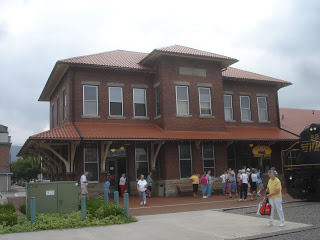 There is an excitement that accompanies walking toward a restored and immaculately maintained railroad station with "1908" emblazoned on a stone tablet set high below a roof overhang. It's a chance to escape the disposability of today for a brief return to the strength, elegance, and permanence of long ago. The thrill fades a bit when faced with the 'gift shop frenzy' of children and adults pawing through pink engineer hats, multi-colored tee shirts, plastic trains, and wooden train whistles made in China. If you make an honest effort to stick with admiring the architecture, the buzz stays a bit longer. Then the building begins to shake and an ever-louder roar signals the approach of a 1500 horsepower shark-nose diesel-electric locomotive built in 1947. The blast of the horn is deafening and sends whiney children screaming back to their mothers, but sends a welcomed chill down my spine.
There is an excitement that accompanies walking toward a restored and immaculately maintained railroad station with "1908" emblazoned on a stone tablet set high below a roof overhang. It's a chance to escape the disposability of today for a brief return to the strength, elegance, and permanence of long ago. The thrill fades a bit when faced with the 'gift shop frenzy' of children and adults pawing through pink engineer hats, multi-colored tee shirts, plastic trains, and wooden train whistles made in China. If you make an honest effort to stick with admiring the architecture, the buzz stays a bit longer. Then the building begins to shake and an ever-louder roar signals the approach of a 1500 horsepower shark-nose diesel-electric locomotive built in 1947. The blast of the horn is deafening and sends whiney children screaming back to their mothers, but sends a welcomed chill down my spine. Stepping outside I am confronted by a huge beast that sits at thunderous idle, diesel fumes spewing from its exhaust stack. Power throbs from within it, vibrating anything nearby. It is sleek and beautifully curved, painted shiny black and emblazoned with "WESTERN MARYLAND" in bold yellow letters that seem to extend to the horizon. Like the impulse to touch a wild animal, I am filled with the desire run my hands over the smooth, curving surfaces. High above me the large glowing headlight shines like a single eye. All about the machine are wires, pipes, and conduits. A pipe railing guards workers who must stand at the front as well as inconsiderate and disrespectful tourists. High above sits the engineer in his windowed chamber, master of all that will happen on this day. There is a feeling of awe that mere men could build such a grand and powerful creature as this.
Stepping outside I am confronted by a huge beast that sits at thunderous idle, diesel fumes spewing from its exhaust stack. Power throbs from within it, vibrating anything nearby. It is sleek and beautifully curved, painted shiny black and emblazoned with "WESTERN MARYLAND" in bold yellow letters that seem to extend to the horizon. Like the impulse to touch a wild animal, I am filled with the desire run my hands over the smooth, curving surfaces. High above me the large glowing headlight shines like a single eye. All about the machine are wires, pipes, and conduits. A pipe railing guards workers who must stand at the front as well as inconsiderate and disrespectful tourists. High above sits the engineer in his windowed chamber, master of all that will happen on this day. There is a feeling of awe that mere men could build such a grand and powerful creature as this.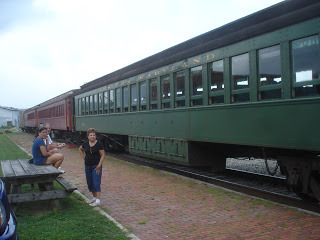
At the appointed time the mass of passengers is invited to board creating an odd exodus of humanity from the platform into the 1920's vintage railcars. The older and wiser grab the thickly padded seats in the luxury coach while the stragglers and distracted are left to the hard wooden seats of the other two coaches. After several ear-shattering blasts of the horn and a jolt, the train begins to move, leaving the station in Elkins behind.
The next three hours are a journey into history. Atop rails seeing their second century the train cruises along the almost overgrown railway. Tree limbs that defy the best trimming efforts of the volunteers reach out and occasionally brush the cars. Black powder blasted rock walls threaten to crumble onto the roadbed. A long, dark tunnel adds a degree of mystery to the trip. The cars rock steadily as the train continues on its way. The aged conductor provides an enthusiastic narration of the facts and history of the railroad. Mercifully, at the end of the line, two busloads of bored children, exhausted parents, and semi-aware seniors leave the train and return to their charter buses for a trip to yet another excursion railway, leaving only a handful of hearty souls to gather around the conductor while he spins yarns and tells the stories that would have been wasted on the busloads. Now the trip begins to have meaning, creating memories worth remembering during the three hours back to the station.
One of the things I learned was that a six hour trip is long whether by train, airplane, or bus. I was grateful to finally be on firm ground again, but I could not resist one last admiring study of the grand old engine that had served us so well. I feel a kind of kinship for anything that has spent 63 years working hard and will be back again tomorrow to do it all again. Better it than me.
DAY TWO:
Where IS this place? The four-lane became a two-lane. The two-lane became a twisting, winding, narrow monster that climbed and crashed like a roller coaster. Mapquest had been accurate in its 1-1/2 hour time estimate of the trip from Elkins to Cass, but what it didn't tell me was how much really hard driving I would encounter. Finally a valley opened up at the end of a small village of white-painted houses and other buildings to reveal a train station and a cluster of white-painted industrial buildings. The paved parking lot was wide and not crowded at all, affording me convenient parking. Welcome to Cass Scenic Railroad State Park. Fortunately the 'will call' line for pre-paid tickets was much shorter that the 'Buy Tickets Here' line where adults couldn't seem to understand phrases like, "We cannot accept personal checks" and, "Children over 12 pay adult fares". We pitied the poor ticket clerk who had to answer a stupid question with, "We cannot tell you where to put your dog, but it cannot go on the train." I got the impression that for some people, the train to common sense stopped long before it reached their station.
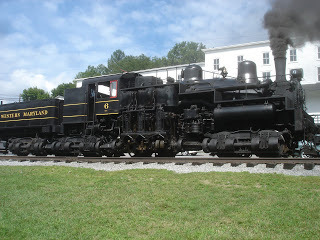 Ticket in hand, I carefully avoided the gift shop in favor of an old corrugated metal building labelled "Cass Showcase". Once inside I was treated to a scale model of the town as it existed in 1908, a narrated history provided by a knowledgeable gentleman, and a wonderful 10-15 minute movie. All were quite interesting, and the end of the movie was punctuated by the melodic scream of a steam whistle. When I exited the building, a huge black steam locomotive with four passenger cars sat at the depot. I would learn later that the engine before me was a 160 ton Shay steam locomotive, the second largest ever built, constructed in 1945 in Lima, Ohio. It was a magnificent creature, vastly different from the shapely diesel of Elkins and unlike anything I had ever seen.
Ticket in hand, I carefully avoided the gift shop in favor of an old corrugated metal building labelled "Cass Showcase". Once inside I was treated to a scale model of the town as it existed in 1908, a narrated history provided by a knowledgeable gentleman, and a wonderful 10-15 minute movie. All were quite interesting, and the end of the movie was punctuated by the melodic scream of a steam whistle. When I exited the building, a huge black steam locomotive with four passenger cars sat at the depot. I would learn later that the engine before me was a 160 ton Shay steam locomotive, the second largest ever built, constructed in 1945 in Lima, Ohio. It was a magnificent creature, vastly different from the shapely diesel of Elkins and unlike anything I had ever seen.
An incredibly complicated machine, it had a boiler and a cab, but other than that it bore no resemblance to the usual steam locomotives. There are three exposed steam cylinders on each side and the cylinders drive a long crankshaft along the lower right side of the unit. This crankshaft drives gears at each of the six wheels, including two beneath the tender. Since the six wheels are rigidly connected to axles and the wheels on the other side, technically it is a 'twelve wheel drive' machine. It is the locomotive equivalent of 'all wheel drive', which was necessary to negotiate the steep grades encountered while climbing the mountains where logging operations were being conducted. As I studied it, I began to realize what an absolute marvel it is that something like this could still be in regular service after all those years. Unlike the relatively smoke-free diesel, a steady cloud of black coal smoke chugged from the stack while water leaked from the botton and steam hissed from relief valves. It was both frightening and strangly magnetic at the same time. It was like staring at a bomb with the strange compulsion to see what that large red button does.
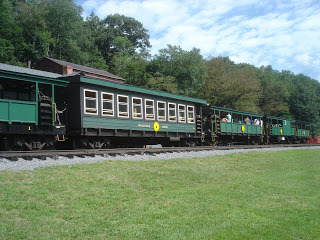 Three of the passenger cars were open-air with a roof and continuous bench seats that faced outward, while the other was enclosed. Rather than fight for a place in the 'cheap seats', I had reserved a seat in the 'first class' enclosed car that left me in the company of about a dozen other hearty souls. It didn't take long for most of us to abandon the seats in favor of standing at a window. With the cars loaded, the steam whistle screamed again and we were on our way.
Three of the passenger cars were open-air with a roof and continuous bench seats that faced outward, while the other was enclosed. Rather than fight for a place in the 'cheap seats', I had reserved a seat in the 'first class' enclosed car that left me in the company of about a dozen other hearty souls. It didn't take long for most of us to abandon the seats in favor of standing at a window. With the cars loaded, the steam whistle screamed again and we were on our way.It is right that different locomotives have different styles of horns. The diesel at Elkins had a deep, badass horn that could peel the paint off of a building, but it would have been entirely wrong for a steam train. The steam locomotive had one B-I-G steam whistle, the kind that companies used to have to tell employees when the shift had started or ended. Any of you who remember company towns will also remember the big steam whistle that was the focal point of the day. It would echo through the valley and carry for miles. Like the last school bell, everyone eagerly awaited the afternoon whistle marking the end of the shift. And occasionally, an untimely whistle meant that someone's Father wasn't coming home.
The engineer on this steam train was a maestro in his own right. Rather than just the required blasts, he created staccato rhythms and sliding melodic tones as a signature in which, I'm certain, he took great pride. With whistle blowing, we started down the tracks from Cass past a line of other locomotives in various stages of restoration or dismantling. We passed various storage cars and the large shop where the old is made new again, or at least patched up for a few more days. Then we started up the mountain.
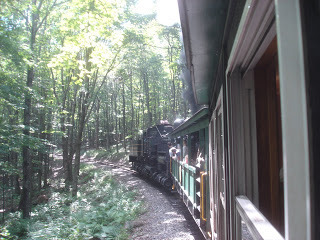
Most trains operate at a maximum grade of about 2% or two feet vertically in one hundred feet. Beyond that, their drive wheels begin to slip on the steel rails. Applying sand to the rails may help gain an extra percent or two, but that is about the limit. Almost immediately we were at 9%, a gradient that sent most people to their seats and kept them there. The ancient engine worked its mechanical heart out with clouds of bellowing smoke and flying pistons spinning the driveshaft. But up we went.
A switchback is like a landing on a long flight of stairs. You travel as far as you can in one direction, then pull into a level area, throw a rail switch, and start up again in the opposite direction to the next switchback. This continues as many times as necessary to get the huge load up the steep part of the mountain to an area where the grade flattens out. Pretty amazing stuff for 1908 and equally amazing that it is still in operation 100 years later.
Whitaker Station was a staging area where the loggers set up what they still call a 'yarder' that drags the felled logs on a cable to a central point for transport down the mountain. The cables could stretch for miles and tens of thousands of logs were removed this way. What I found interesting was the gigantic scope of the operation. This wasn't Joe Bob and Billy with a saw and a team of mules, this was dozens of teams of men who cut and moved trees 11 hours a day, 6 days a week for years. History says that the mountain was clear cut in the 1900's, then again in the 1930's, but you would never know it today. The mountain is so thickly wooded that the tree canopy is continuous as far as the eye can see. Even from the top of the mountain there are no open areas save for a handful of farms on the few flatter areas. I remember those sad old pictures from the 1900's that showed land cleared for miles around with acres of stumps and unprotected soil. They were usually accompanied by pictures of mustashioed men in front of a large train or in front of a pile of logs and shown as part of a PBS special on soil erosion. The earth is a very resilient critter.
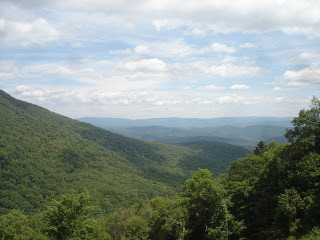
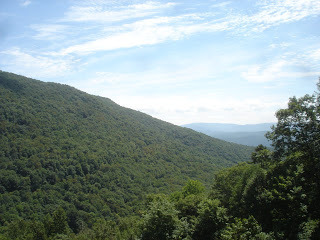
After visiting the sites of two abandoned logging towns and a couple of engineering feats, we began our descent back down the mountain. It is disconcerting to start down an 11% grade in front of 160 tons of steel and steam on wheels. Looking through the open cars at that huge boiler, I couldn't help but hope that those 65 year old brakes would hold until we reached level ground. Despite trust in competent people, there seems to be a point where those 'Stephen King' thoughts start to pop up. But in the end, thoughts were needless as we slowly and steadily returned to the Village of Cass.
All told it was a very nice couple of days. I have grown to appreciate history and the people who comprised it. It is equally satisfying to experience the efforts of those who put their passions into action so that others may experience a bit of the times long behind us.
March 27, 2010
"Can't Get Enough of That Funky Stuff"
"Hello, my name is Randall and I'm a funk addict."
"Hello Randall."
Unbeknowst to me in my childhood, I was born with a redundant rhythm chromosome. It wasn't until my early teens when the musical white wasteland of Patti Page and Julius LaRosa gave way to the likes of Wilson Pickett, Rufus Thomas, and Sam & Dave that the stirrings of something unusual began to appear. By the time Motown hit the airwaves, I was completely addicted to pulsing bass lines and a solid beat. With the discovery of James Brown and the Famous Flames, I finally came to grips with the fact that I had a deep and inescapeable sense of rhythm that would rival an atomic clock, a condition that was certainly far from typical given my race and rural upbringing. As the years went on, my insatiable lust for funky music soon meant that dancing was not enough, I HAD to PLAY that funky stuff! From the first time that drumsiticks met my hands, everything else in life became virtually meaningless. The pursuit of funky music lead me to seek out players of said funky music and finally coupled me up with a blind genius on a Hammond B-3 organ, the master of a Gibson Les Paul, and a singer whose deep voice and perfect smile could melt womens' underwear from 50' away. Life was good and VERY funky.
In 1974, a saxophone player friend said, "You have to hear these guys."
"Who are they?"
"Tower of Power...from Oakland, California."
"Oh?"
He put on a vinyl record and the most incredible music I had ever heard met my ears. It was what they called "Urban Funk", and it was a driving, solid beat, a killer bass line, chunky guitar licks, beautiful Hammond organ parts, and a horn line of trumpets and saxophones that bumped and blasted their way through each song, interspersed with the growl of a baritone saxophone. The tight, professional arrangements were performed flawlessly beneath a blues vocal line that just left me breathless. The next day I bought "Urban Renewal", still my favorite album.
Thirty five years later - Life has intervened and my music playing days are history but that annoying rhythm chromosome simply won't die. I've tried burying it, forgetting it, ignoring it, laughing at it, but nothing seems to make it go away. As a gift for Your Most Humble and Obedient Servant, Mrs. Randall secretly secured tickets for a Tower of Power concert located in Falls Church, Virginia, near Washington D.C., at a venue called the State Theater. She surprised me with an entire room and dinner package to go with the concert. For as much as I dread going anywhere near Washington, D.C., this was a bucket list item.
The State Theater is hardly an architectural landmark. It's basically one of those grand old neighborhood theaters that lost its grand many years ago. Somebody bought it and renovated it for live shows that will accommodate maybe 300 people. They added a kitchen and several bars, removed the first floor seats, and put in tables that allow patrons the flexibility of dinner seating, balcony seating, or "mosh pit" style standing between the tables and the front of the stage. Mrs. Randall, in her wisdom, had reserved a dinner table for two that turned out to be in the front row of tables and about thirty feet from the center of the stage. A 'wow' in its own right.
The band had already set up and rehearsed before we entered the theater. We were taken to our table and promptly ordered dinner as the theater began to fill. I could not resist going down onto the floor; I HAD to get closer to the stage, if only for a short time. In the dim light of the largely dark stage stood Tower of Power's equipment including David Garibaldi's drum set. I stood staring as if I were seeing a holy relic or a shrine. After all those years of listening to the true master of the instrument amaze me with his ability, there before me sat the tools with which he created his magic. I felt so unworthy.
The theater began to fill, but not with kids and not with twenty-somethings...or thirty-somethings. Forty was a starting point for most, and I couldn't help wondering how all those grey hairs were going to stand through two hours of a rocking show. I was damned glad to have our seats, and really great seats they were.
The stage lights lit up and out came the members of Tower of Power. I guess I somehow expected to see the same bunch of guys from the album covers, with open shirts, bell-bottomed pants, beads, and big afro hairdos. Out came ten guys in blue jeans, tee shirts, and ball caps; grey haired if not bald; pot bellied, and not at all looking like what my mind had invisioned. They looked more like plumbers, auto body repairmen, and high school football coaches than like musicians. I had spent much of my life around musicians and the only one looking the part was the bass player who looked like a guy fighting heroically to overcome his meth addiction. I don't know what else I had expected, but it was a bit startling. Of the two founders, one looked like Geppetto the wood carver and the other resembled a Korean dry cleaner. Pretty ordinary looking guys to compose a band I had been in awe of for 35 years. Then they picked up their instruments and the stage caught fire!
I don't know if someone who has not been involved with music can understand the level of skill and precision at which this band operates. Each member is not just a complete master of his instrument, each also plays very complicated staccato parts without missing a note. The music was all there, without variation, from 35 years ago. I have never grooved so hard. Their music swept me up so completely that my feet moved in eighth notes, my shoulders rocked in time and my head bobbed at each bump & blast. At one point I had tears streaming down my face. There are few religious experiences to rival what happened to me as my rhythm chromosome swelled to the size of a basketball.
I had to watch David Garibaldi play. I've watched some of the greatest play before and they have a way of making the impossible look easy. For years I had listened to David and couldn't believe my ears. Now I watched and couldn't believe my eyes. His bushy brown curly hair is gone now, replaced by close-cropped, tightly curled grey hair, but those incredible hands are as good now as they ever were. I remembered when I played, my body grooved along with the music I played, but the truly great players don't seem to do that. The great ones that I have seen have a "ho-hum, just another day at the office" look that always astounded me. The man is a rhythm machine playing at a level light years beyond anything I could have ever achieved, and yet his degree of dispassion is disconcerting. How can ANYONE groove that magnificently and not feel it to his very core. I sure felt it. For two solid hours and an encore my body pulsed and rocked to the magic of a bunch of ordinary looking guys who make absolutely masterful music. And I wasn't alone. 300 other geezers grooved and screamed like a bunch of fourteen year-old girls at a Jonas Brothers concert. It's a wonder that 911 wasn't flooded with heart attack calls.
As we left the theater and walked into the chilly night, I couldn't help thinking that, if I lose my hearing tomorrow, it would be all right because, as far as I am concerned, I have heard music played the way God intended and it can get no better than that.
http://www.towerofpower.com/
http://www.youtube.com/watch?v=7LjrCV4Gnxw
November 15, 2009
"This Is It!"
I didn't grow up with Michael Jackson, I'm more of a Beach Boys, 'Louie Louie', and Supremes/Temptations guy. Michael hit the video world about the time that my children were growing up, so he filled our television with hit video after hit video as fast as MTV could post them. Putting aside his proclivity for crotch grabbing, Michael was an amazing talent. His songwriting, singing, and performance skills were light years above his contemporaries. What I didn't realize was the true depth of his ability. Like most people I just assumed that behind the scenes were musical directors, choreographers, and a myriad of other coaches saying, "Michael sing this", "Michael do these steps", "Michael make these movements." It seemed reasonable that there were lighting consultants, special effects managers, audio experts, and a flock of other specialists who expanded a basic idea into a super-show. During the movie I learned that it was not that way.
Michael Jackson had morphed from a music star into a freak show, hounded day and night by a starving media who used any opportunity to expose his bizarre and yes, possibly criminal behavior. His Maker can be the judge of that. The media dragged his life in color photos into the sleazy tabloids so that the more curious among us could get their regular dose of strangeness. And the band played on...for years.
Your most humble and obedient servant, in his younger years, was guilty of being a musician, comic, dancer and, on a few especially forgettable occasions, singer. Those misspent but intensely enjoyable years taught me many hard truths that performers go to great lengths to disguise. Basically, that performing in public is a LOT of hard work, and the effort that goes into presenting even the simplest of shows would surprise and amaze the average audience member. Any show requires planning, skill, knowledge and perspiration before the talent can be showcased. The greater the 'wow factor' of the show, the more intense the requirement for precise organization and professional skills.
The Michael Jackson movie followed the development of "This Is It!" from the auditions of the singers and dancers through the assembly of the show and the endless rehearsals. More than just 'singin' & dancin'', the show was filled with hydraulics, pyrotechnics, computer-generated effects, specialized lighting, make-up, costumes, and mechanical systems. As it opened up, I found myself mentally wondering, "Who dreams up this stuff?". It wasn't long before I learned that Michael Jackson had dreamed up that stuff.
Yes, it amazed me too. The thought that a strange character who walked around wearing a mask and sheltering beneath an umbrella actually had the ability to create a Disney scale stage show was difficult for me to swallow. But that is how it was. The music was his and he knew exactly how he wanted it to sound. He knew what key, what volume, and what tempo he wanted. He knew every move the dancers were to make and when they should make it. He dictated when the stages, the lifts, and the rope hoists were to activate. He specified the special effects and supervised their timing. He called the lights and knew when anything was out of place. And, as if that wasn't enough, he sang every note and danced every energetic number with a 50 year old body and voice that had been away from it for many years. The much younger chorus dancers and back-up singers would stand in awe of this legendary man as he worked his magic tirelessly for hour after hour. They were inspired by his presence and stood open-mouthed and applauding as he finished each number. If you haven't guessed by now, they weren't the only ones in awe of Michael Jackson's abilities, I plead guilty also.
I always considered the 'Jackson Five' to be a 'kid band' who had no business out there competing with those of us adults who were struggling to keep the dream alive with four nights a week on stage at the Holiday Inn. Kid bands were cute and all, but they just didn't have the 'gravitas' of us 'true professionals'.
Even when Michael exploded into the music world with 'Thriller', I was still sure that he was just the front man for a giant organization who simply plugged him into position and told him what to do. How amazingly wrong I was. In reality he was a monster talent, a giant showman with capabilities that average people could never fathom. What an immense loss of talent this world has suffered.
"This Is It!" had completed production and was scheduled for dress rehearsals and the grand opening in London. It was a little over two weeks from the opening when Michael Jackson suddenly died. Months of rehearsals, millions of dollars, and the dreams of dozens of performers evaporated, the victim of a handful of mixed prescription drugs. And the world was robbed of what might have been one of the greatest stage shows of all time. Michael Jackson's wondrous legacy vaporized in an instant leaving behind the scarred images of "Wacko Jacko". His death is far more of a loss than most people will ever know. RIP "MJ".
October 25, 2009
Number 45
Friday night was the first get-together at a rented chalet in Oglebay Park near Wheeling, WV, and just walking from the car to the front door was an unnerving experience. Will I recognize everybody? Hell, will I recognize anybody? I was about to be face-to-face with 18 people, only two of whom I had seen in the past 45 years. Opening the door to the well-appointed chalet, I observed people who stood talking comfortably in several small groups. It was a good thing that I knew names because I recognized few faces. There was a predominance of white hair...when there was hair, a lot of extra pounds, lots of wrinkles, and some significant facial hair. The smiles were still there and they were still a friendly bunch although the liquor may have improved that aspect. It really didn't take long until, drink in hand, I joined them with greetings, a few old and fat jokes, and a lot of catch up stories. A lot happens in 45 years.
Our school had been small and all-male, with just 42 in this graduating class. There had been the usual groupings of jocks, nerds, over-achievers, under-achievers, and a few non-descripts. We had no 'goths', anti-socials, or psychotic weirdos as most larger schools seem to have. Those had largely been filtered out by the process of natural selection combined with strict academic requirements. It's hard to become a head-banging heavy metal freakazoid when you have a monster physics test at the end of the week. So those who remained were stable and accomplishment-oriented individuals with goals in mind and the intention to become contributors to society. And after spending an evening catching up, it appears they had indeed succeeded at both accomplishment and contribution.
In this small group, most had letters either before or after their names. Letters like MD, PhD, LLD, PE, CMDR, COL, ESQ, and some that I honestly didn't understand but I knew represented professional accomplishment and recognition. Pretty impressive for a bunch of nerdy geeks who couldn't field a winning football team. They brought with them their wives, most of 35 to 40 years or more. Mature, attractive women with winning smiles, tremendous social skills, most with advanced education, and an unshakable committment to their husbands and families. Not one blond bimbo or trophy wife among them. The evening became enjoyable very quickly.
Eventually we reflected upon those in our class who had died. Graduating from school at the height of the Vietnam War had pushed many of our number into military service, but we were fortunate that all returned. Some had even chosen to make the military a career. We had since lost only three to natural causes. The 'gorilla in the living room' was the unspoken question of how many more of us might be gone before our next reunion.
It is hard to see change in yourself, but it is easy to see it in others. Especially in a 'time warp' situation when that 17 year old buddy (chasing chicks, racing cars, and trying to get away with drinking beer) is 45 years later a renown heart surgeon...or was the commander of a guided missile cruiser...or the CEO of a world-wide corporation. We sat surrounded by luxury, a group of accomplished, respected, and apparently successful individuals who had gone their own ways and, by and large, had accomplished their goals. Yet there was no snobbery or 'competition of egos' in this group. The old cliques and social stratifications had completely broken down and a spirit of genuine camaraderie developed. By the end of the evening I couldn't help wishing that the whole bunch of old, fat, (largely) bald guys could live in a village somewhere so we could spend evenings such as we had just enjoyed on a regular basis instead of at 45 year intervals.
The next day we went on to attend school-sponsored alumni functions where speakers talked of lofty future plans while honoring us and sliding donation forms under our noses. My high school buddies and I have now become the Fathers and Grandfathers who keep the wheels of education well greased with the proceeds of our success. I guess that was inevitable. I remember being a student and watching fast-talking guides showing groups of old coots around campus and snickering at the whole drama. I don't snicker any more now that I am among that bunch of coots. Now I look at those shiny young faces and wish that we coots could trade places with them, even if it was for a short time. To once again be able to run fast and love quickly. To re-experience the newness and excitement of life through the freshness of youth. To face drama and turmoil with the knowledge that life stretches out before us like a new highway to the horizon. But that would not be fair. We had our time and now that time is past. But for one fleeting weekend that ended entirely too soon, a group of men whose highways stretch much further behind them than they do ahead, looked into faces of age and saw faces of youth.
September 30, 2009
Danny Died On Monday
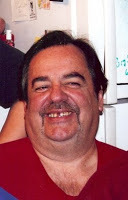
The panicky telephone call came about eleven PM on Monday. On the other end the woman's voice was erratic, tear choked, and hysterical.
"Can you come over? Oh God, I think he's gone!"
Throwing on clothes over pajamas, I rushed to the house next door to find Danny's wife Irma shaking, crying, and hysterical. Danny lay on the couch, eyes closed, ashen grey and not breathing. CPR had no apparent effect but was continued for the few minutes until the medics arrived to take over. After that, all that could be done was to comfort Irma and assist in making telephone calls. Within the hour a doctor at the local hospital pronounced Danny dead of apparent heart failure. A family's world fell apart.
Danny was a great neighbor. He wasn't a close friend, but he was a great neighbor. My requests to borrow tools or for help with some project were always met cheerfully. Sometimes even when I didn't ask, he would offer. I would hear a mower in the backyard and go to the window to see Danny go by on his tractor. There were no property lines, it was all just grass to Danny. He was that kind of guy.
From the covered patio of his corner house the sound of loud voices and raucous laughter frequently echoed through the neighborhood. Danny seemed to host an odd conglomeration of co-workers from the local university, neighbors, relatives, and some who were probably just 'show-ups'. The beer flowed freely as did the laughter. Eventually the locals designated him as 'The Mayor', holding court on any warm afternoon, and adding spirit to the neighborhood.
Danny only knew how to be Danny, so you could take him or leave him, suit yourself. There were no pretexts, attitudes, or attempts to impress, just a genuine hard-working man with a receding hairline, a growing belly, a gap-toothed smile, and an infectuous laugh. His language was coarse and his jokes raunchy, but that was a part of him, so if you didn't care for it, well, your feet ain't set in cement.
Danny was fifty-eight years old and leaves behind a shattered wife, three grown daughters and a son who have all lost their peculiar anchor, and several grandchildren who are trying to make sense of it all. The funeral will be crowded, and a lot of tears will be shed. The funeral procession will be long and there will be trouble finding room for all of the cars at the small country cemetery.
'The Mayor' is gone and that loss will take a while to settle over the neighborhood. There will be an unusual quiet on the corner and a lot of people will notice the difference without really understanding why. Anheuser-Busch will have to lay off half of the second shift and not understand why. Goodbye 'Mr. Mayor', we miss you already.
September 21, 2009
A Forest of Souls
As a part of that tour I had written a piece about one of the places I had visited while doing research for Magnificent Man. The Saguaro National Park is outside of Tucson, Arizona and is the desert equivalent of a national forest. There is a scene in Magnificent Man where Coyote takes Cassandra to visit the souls. It is his belief that the souls of the departed dwell within the tens of thousands of tall saguaro cacti. The place is hot, dry, dusty, and dangerous, but it is hard not to become caught up in Coyote's belief. I call this post, "A Forest of Souls".



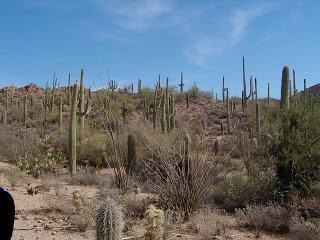
***
I started to write a romance novel that took place in the contemporary American southwest. The idea was there, the plot was forming, and the story was cruising along quite nicely until I hit a wall. My characters were in the stark and beautiful desert country of Arizona, but the problem was that I had never been there. Big problem. The day I had selected to fly to Tucson began as a disaster when the air traffic control computer at Dallas-Fort Worth Airport picked THAT day to crash. So now my ten A.M. flight became eleven-thirty and eventually left around two-fifteen. Oh well, welcome to modern travel. What I was not prepared for was my five P.M. flight to Tucson from Dallas-Fort Worth finally being cobbled together out of used plane parts at nine-thirty P.M. All told, a rather dubious start to an otherwise wonderful trip. The car rental desk in Tucson had graciously stayed open to make sure I actually had a car for my research trip, so somewhere around eleven P.M. I was speeding off into the still warm night.
So began my journey of research and discovery in the Arizona desert. During the following weeks I travelled to many places and frequently stood out as an obvious light-skinned stranger among people with deeply tanned skin and facial features and clothing that greatly differed from mine. Some spoke our language with a heavy accent, while others struggled to understand my words. The people were different, their way of life was different, and the land was very different from anything I had ever experienced. I remembered the old John Wayne and Randolph Scott western movies that had been filmed in some of the places that I visited, but it was all just so...different. It was hot, even in November, and dusty, and dry. The heat shimmered like water and the wind flowed slowly as if to conserve its energy. The flat land stretched for miles before crashing head long into the steep rock buttes and mountains. There were many places and people, not in the least glamorous, but deeply imbued with history and culture. It was impressive just to be in their presence.
Among the many places that I found striking was the Saguaro National Park outside of Tucson. It is a very modest place by national park standards; just a welcome center and a lot of desert. You don't have to pay, you simply turn off of an asphalt road onto a dirt road and drive slowly to avoid choking yourself in dust. On the day I was there, very few other vehicles came along allowing me the luxury of pulling off at leisure to become absorbed in the place. Here in the east we are very accustomed to forests of trees. Great stands of pine or hardwood trees that shade the forest floor. Everywhere in this park were cacti. Much of the low growth was a variety of spiky and spiny nastiness shaped like barrels, gangly whips, Mickey Mouse ears, fuzzy coral, and some that just defy description. I was very satisfied to get no closer than I was to any of it, and was most sincerely glad to have no reason to attempt to go through it. But dominating the land for acres, if not square miles, were the famous saguaro cactus (pronounced locally as su-WAR-o). These are the tall cacti that are the state symbol of Arizona. They grow slowly and can live for as much as two hundred years. After 75 to 100 years they can start to grow the iconic arms for which they are known. There I was among tens of thousands of the saguaro in a strange forest-like setting.
In Magnificent Man, Coyote, the hero, takes Cassandra to the saguaro land and tells her the story of the souls. He explains that each tall cactus represents the soul of a departed desert native. He becomes emotional while looking out at the immense number of saguaro and picturing within each the soul of one departed. The warriors, the women, the children, all still together in this desolate and hostile place, but finally at peace. A forest of souls.
June 19, 2009
I made a video!
WOW! This is really exciting! I made a video and it has Michael Jackson moonwalking, Madonna being slutty, Peter Gabriel as Sledgehammer, and Natalie Cole singing with her dead Father!
Well, not really. The reality is that it's just another book trailer, like hundreds of others out there, and the only exciting thing about it is that I did it myself. When you're as computer-illiterate as I am, just getting the damned thing to start up on any given day is an accomplishment. When you don't know a 'gigabyte' from a cheeseburger, the idea of creating an official U-Tube style video is more than a couple feet off of the radar screen. I found a program called "Windows Movie Maker" on my machine; apparently it's a standard part of Windows XP. I had never noticed it before, but then there are a dozen other programs just like it that I never noticed either. When I opened it, I found that, if you actually follow the instructions, it's a really nifty little program that is NOT all that hard to use, and you don't have to be a seventeen year-old C++code writer from New Dehli to actually get some results. It took the biggest part of a day to manipulate pictures and text into a timeline, and then to adjust them so that there is enough time for a reader to actually read the text before the picture changes.
I spent hours looking for sound effects to match screen actions and finally selected and downloaded just the right ones. What I didn't know was that, without more sophisticated softwear (and a more sophisticated user), I couldn't blend music with sound effects to get that 'REALLY COMPLETE' feeling. In the end, I had to lose the sound effects and go only with the music, which is not bad. The only annoying feature of the resulting 'movie' is that the ending screen remains blue instead of going to black as the program was CLEARLY instructed to do. Oh well, it still came out kinda' cool.
Magnificent Man is a story that takes place in the American southwest against a backdrop of extraordinary scenery and Native American and Mexican peoples. I wanted to share as much of that feeling as I could with anyone who cares to watch my 'Cecil B. De-Mini' epic. Comments are appreciated, even the ones that say, "It really sucks." For now, I'll just sit back quietly and wait for the reviews in Variety, and start drafting my acceptance speech. "I want to thank the members of the Academy, and my parents, and all the little people who made all of this possible." Ciao Baby!
June 14, 2009
A PLACE THAT FEW HAVE SEEN

For a large part of my working life, I was in places where, if God decided to kill me, my death would be considered a routine hazard of the job. Where I grew up there were many trains, and all I ever saw them carry was coal. If it were not for books and Lionel trains brochures, I would never have known that trains moved anything but coal. The Fathers of most of the children I went to school with worked in the coal mines and a few of those Fathers went to work one day and did not come home. Anyone in my part of the world who has been near a river has almost certainly seen powerful towboats churning the water as they pushed numerous barges piled high with coal. Where I grew up, the roads were slowly pounded into dust by the seemingly never-ending parade of large coal trucks. Coal is America's real energy source and I was in the heart of coal country.
Comparatively few people have ever actually seen where that coal comes from, and I suppose that even fewer care. Geologically speaking, the coal was created when prehistoric swamps, filled with all manner of organic matter, were covered over by layers of sediments, and pushed down further and further as the land around them rose up. The final result of the tremendous pressure and ions of time was the conversion of black slimy swamp ooze into thousands of square miles of a hard, black, and shiny mineral that releases tremendous heat when burned. It is so valuable that men kill each other over its ownership and its recovery.
Most coal beds or 'seams' as they are more accurately called, lay very flat and are of relatively uniform thickness. The most famous seam of all, the Pittsburgh coal seam, is nine feet thick and, in general, ideal for mining. Imagine walking up to a remote and relatively steep hillside, and scraping away the earth and soft, weathered rock to expose a layer of shiny black coal higher than your arm extended over your head. So high that, after removal, you can walk upright and comfortably into the void. Now create eight openings into the coal seam, each sixteen feet wide by nine feet high, and space those openings about one hundred feet apart. Support each opening with a reinforced concrete arch. Then, continue to mine each opening back to a depth of about one hundred feet, being careful to support the roof of each tunnel using wooden posts and timber beams, or a system of six-foot to twelve-foot long steel bolts connected to expansion anchors set into drilled holes in the solid rock above the coal. Now, turn and start a tunnel at a right angle to the original tunnel, and do not stop mining until you have connected all eight of the tunnels together resulting in square blocks of coal roughly one hundred feet square. Now you have a coal mine.
Continue the process just described for thirty five years and, lo and behold, you have a network of tunnels that stretches for eight or ten miles and has honeycombed hundreds of thousands of acres while producing millions upon millions of tons of coal. For an operation this large, there will be multiple concrete-lined air shafts, eight to ten feet in diameter, and dug from the surface to the coal seam, a distance typically of six hundred to eight hundred feet. Huge mechanical fans, six to eight feet in diameter, are installed on some of the air shafts. These fans, by law, must run continuously to remove dust and toxic and explosive gases from the mine. There will also be an elaborate system of narrow gauge railroad tracks with an electrical trolley wire, similar to the old street cars. This is used to transport men and supplies into the mine and sometimes to bring the coal out. More commonly a system of conveyor belts runs continuously from the outside to the active mining area in order to transport out the mined coal. Finally, there is a network of high to medium voltage electrical cables and transformers to power everything; miles of telephone and signal wires; and, large pumps and discharge pipes to remove accumulated water. Welcome to my world; a place seen by a relative few, but whose existence contributes to the lives and economic benefit of innumerable people in some way or other.
From the first time I rode down the shaking and rattling elevator in my brand new coveralls and sporting my new miner's cap, I knew that this was a special place. There were sights, sounds, and smells that were not duplicated anywhere on the surface. I was entranced by the steady swoosh of the conveyor belts and the click-clack of the large locomotives pulling their trains of supply cars. The smells of 'sulfur air', wintergreen snuff, and hot grease permeated the air. However, it was the darkness, the complete darkness broken only by the glow of a cap-mounted electric light that kept me attuned to the potentially hostile environment in which I found myself. The loss of that meager beam would render me helpless and completely blind.
In later years my accumulated certifications qualified me to make the mandated safety checks of old unused areas located miles from the active work areas and far distant from another human being. Most times I was closer to people who lived on the surface, six hundred feet above me and unknowing of my existence, than I was to another worker inside the tunnels. I don't believe that many people have ever experience true solitude. Not just quiet house solitude or even, marooned on a deserted island solitude, but actual and complete sensory deprivation. While underground and alone, I could sit and shut off my light to experience the absolutely most complete silence and darkness that anyone can ever experience. Imagine being buried alive but knowing that you can get out. That unusual environment results in an extraordinary psychological situation in which your brain has no visual or auditory input, and it does not know how to react. Your mind screams, "Relax, this is only temporary", but the brain does not listen. It goes into a kind of panic mode with fascinating results. Soon, in the complete darkness, clear but dim soft gray images begin to appear of what your mind thinks that you should see. Very faint, meaningless sounds soon start at a level where your mind is confused as to whether you actually hear the sounds or not. It is impossible to tell. The images are as clear but ghostly, as if they were projected in black and white onto a gray screen. I have on occasion stood up and walked, reaching out to touch the image of a post or a wooden cribbing. I could not see my hand, even though it was extended, but it was startling when my mind was expecting me to touch a solid object and yet none was there.
Imagine, as a writer, having regular access to a place such as this. Imagine the degree of freedom unleashed within your creative processes when your mind is unencumbered by the distractions of sight, sound, and movement. For me, it was a resurrection of the largely suppressed creative centers of my mind resulting in a flood of ideas and thoughts and the beginning of a writing career. Looking back, I probably should have bought a piece of that giant old mine before it closed and rented it out, by the hour, to writers and artists seeking to refresh their minds. Old Amish saying…"Too soon old, too late smart."
June 5, 2009
"Magnificent Man" is here
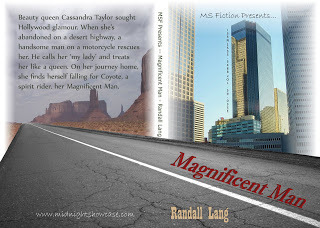
I believe that most people who read or write blogs are readers and writers themselves. For those who are not writers, the process of writing a book is not as simple as it may appear. Everything must start with an idea for a story. The idea must be solid and believable. Then are required characters who are capable of carrying out the idea while putting forth personalities with whom readers can identify. The reward for the characters is that they get to live exciting, bigger than life roles, although some authors will require the demise of a villian, crime victim, or innocent by-stander to generate passion in a story line. I'll bet those characters weren't happy about that. Even after the story is written and "the end" is typed, the work is but half done. Then comes the proofreading where those misspelled words and grammatical errors are extracted or corrected. Where the overused words and passive voice are replaced. Where countless hours of work are poked and probed, ripped and redone, realigned and reorganized. Then it all goes to an editor who will open up the story like a wild surgeon with a scalpel, changing, removing, rewording, deleting, and savagely tearing the story to bits while the author grits his/her teeth and hangs on the edge of insanity. After significant amounts of alcohol, medication, or some combination of the two, the author again sits to read his creation and is surprised to find a leaner, clearer, and generally much improved story than the one he/she submitted. Oh the magic of editing.
I have a LOT of words out there. The numerous erotic books I have written have made for delightfully oversexed characters in a variety of enviable situations. They were fun to write and I hope that readers enjoyed reading them. I had originally started out just to write some pseduo-pornographic meaningless stories about large breasted women and well-hung men, but somehow those quickly faded into stories with believeable and likeable characters who have extraordinary encounters during their otherwise ordinary lives. We, the more ordinary but still zestful, can envy them their pleasures.
As much as I enjoyed experimenting with the lives of trailer park people, I developed a longing to write something more acceptable...more 'mainstream'. I have always had soft spot for nobility. Not 'nobility' as in snobby royalty, but rather real nobility of a sort that is lacking today. I looked back to Cervantes and his Don Quixote de La Mancha for a model. A tired old knight, well past his prime and his time, yet still carrying within him an unfaltering spirit of faith, nobility, chivalry, and honesty. There was my hero! There was my man to stand above the crowd clinging to the values that he held unquestionable while surrounded by laughing and taunting jackals. But how do I get such a hero into today's world and where can I put him so that he won't be torn to pieces or worn down by the mass of lessers. It was solving those questions that was the keystone of my "Magnificent Man". Once those were established, the story fell into place like the last pieces of a puzzle. Then I had only to introduce a suitable heroine; a woman who had faced hardship and who had the strength to continue fighting even when the odds were against her. But she had also to be a woman capable of recognizing and respecting the special nature and anachronistic ways of a truly noble man. The meeting of these two personalities was predestined to develop into a deep and inescapable love for each other. But yet another snag! Once the loving bond is made, where do these two bonded lovers live? Do they live in her modern world, where he's considered a 'defective', a laughing stock? Or do they live in his harsh, unforgiving world where one misstep could mean death? THAT became the toughest knot of all to unravel. But in the end, it was unravelled.
But now it is done! "Magnificent Man" hit the stands today and the world has access to the defining effort of my pathetic writing career. Now it will be judged by readers and writer/readers to the tough established standards of erotic romance. Most romance and erotica is written and read by women. There is a shared point of view among women that I will simply never, by virtue of gender, be able to share. I yawn at castles and ballrooms, find no attraction to men in kilts, and pirates and vampires escape me. But I do adore women. I enjoy the sight, the smell, the sound, and yes the feel of a woman. There is a magic in the attraction between men and women and THAT is the true basis for romance. Whether male or female, that is the commonality. I long for the days of elegance in courtship. When a suitor had to prove himself worthy of the attentions of a lady or be left behind. Today the focus seems to be upon the capture or surrender when the real excitement and the genuine pleasure is in the pursuit. A taste of that, Dear Reader, you will find in "Magnificent Man". I am a believer in the Quixotic, in nobility, chivalry, honesty, and faith. And those characteristics I hope will always stand out in my romantic works.
"Magnificent Man" is now available through Melange Books at http://www.melange-books.com/authors/randalllang/randalllang.html/
/.



